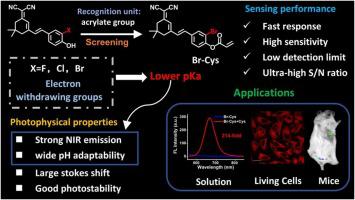Sensors and Actuators B: Chemical ( IF 8.0 ) Pub Date : 2020-06-27 , DOI: 10.1016/j.snb.2020.128441 Ming Qian , Jing Xia , Liuwei Zhang , Qixian Chen , Jianli Guo , Hongyan Cui , Yves S. Kafuti , Jingyun Wang , Xiaojun Peng

|
Cysteine (Cys), as one of the biothiols in organisms, is regarded as a significant participant in the physiological and pathological process. However, monitoring endogenous Cys in living organisms is still hindered due to the lack of effective fluorescent probe with excellent photophysical properties. Therefore, in this work, we attempted to develop excellent fluorescent probes for Cys detection with the aim of improving the photophysical properties of fluorophores. Firstly, through the rational structural modification of the dicyanoisophorone fluorophore by introducing different electron-withdrawing or electron-donating substituent groups, we found that three fluorophores with electron-withdrawing substituent group (-F, -Cl, -Br) exhibited remarkably decreased pKa value and complete deprotonation behavior in physiological pH, endowing the fluorophores with strong fluorescence emission in physiological condition and the wide pH adaptability. Subsequently, we developed three fluorescent probes (F-Cys, Cl-Cys, Br-Cys) for the Cys detection by introducing the acrylate group as the recognition unit into these three fluorophores, respectively. By comprehensively evaluating the sensing performance of three probes toward Cys, we screened out the best fluorescent probe Br-Cys. In solution, Br-Cys exhibited high sensitivity (detection limit: 86.9 nM), fast response (10 min), large fluorescence enhancement (214-fold), good selectivity, and wide pH adaptability. Furtherly, Br-Cys was successfully employed for the specific monitoring of Cys in cells and mice, providing a potential tool for understanding the physiological and pathological functions of Cys in living systems.
中文翻译:

合理修饰双氰基异佛尔酮荧光团以检测活细胞和小鼠中的半胱氨酸
半胱氨酸(Cys),作为生物体内的一种生物硫醇,被认为是生理和病理过程的重要参与者。然而,由于缺乏有效的具有优异光物理性质的荧光探针,仍然无法监测生物体内的内源性半胱氨酸。因此,在这项工作中,我们试图开发用于Cys检测的优秀荧光探针,目的是改善荧光团的光物理性质。首先,通过引入不同的吸电子或供电子取代基对二氰基异佛尔酮荧光团进行合理的结构修饰,我们发现带有吸电子取代基的三个荧光团(-F,-Cl,-Br)的pKa值明显降低。并在生理pH值下完成去质子化行为,在生理条件下赋予荧光团强烈的荧光发射和广泛的pH适应性。随后,我们开发了三种荧光探针(通过将丙烯酸酯基团作为识别单元分别引入这三个荧光团中来进行Cys检测的F-Cys,Cl-Cys和Br-Cys)。通过综合评估三种探针对Cys的传感性能,我们筛选出了最好的荧光探针Br-Cys。在溶液中,Br-Cys表现出高灵敏度(检测限:86.9 nM),快速响应(10分钟),大的荧光增强(214倍),良好的选择性和广泛的pH适应性。此外,Br-Cys已成功用于细胞和小鼠中Cys的特异性监测,为了解Cys在生命系统中的生理和病理功能提供了潜在的工具。











































 京公网安备 11010802027423号
京公网安备 11010802027423号